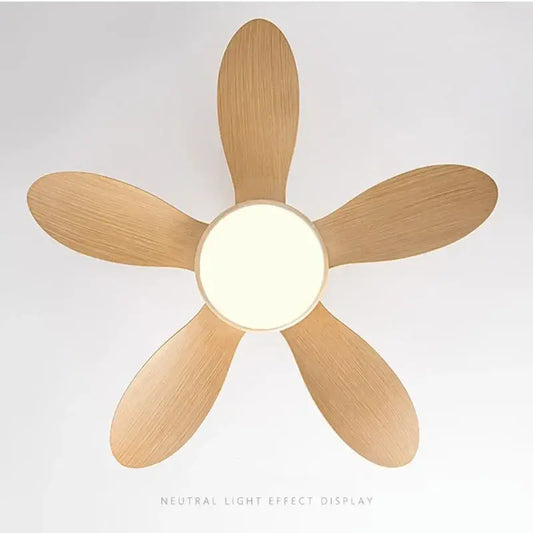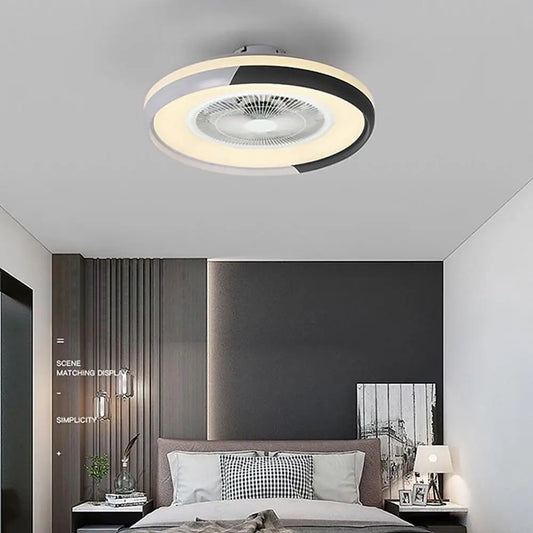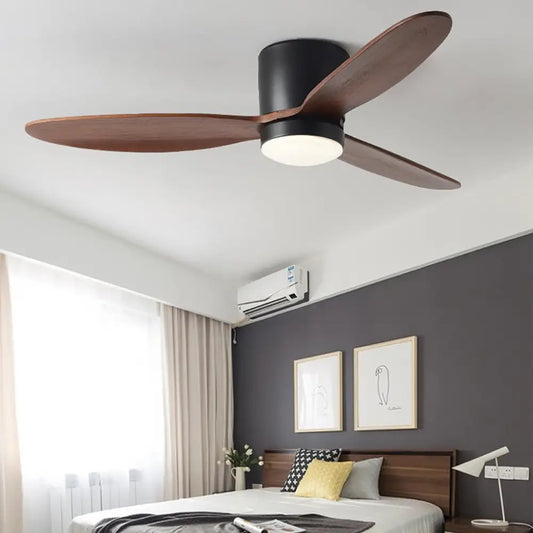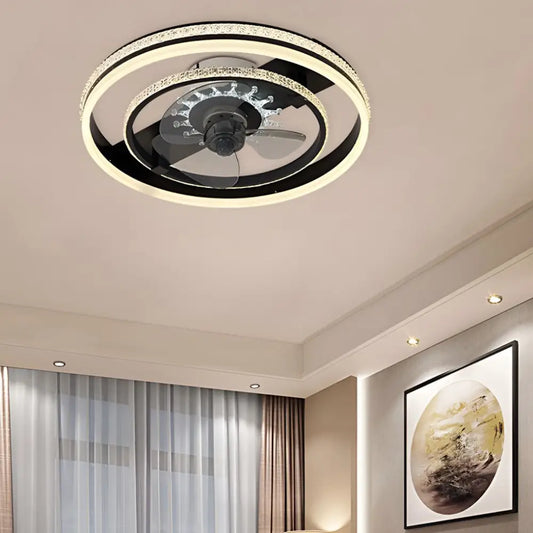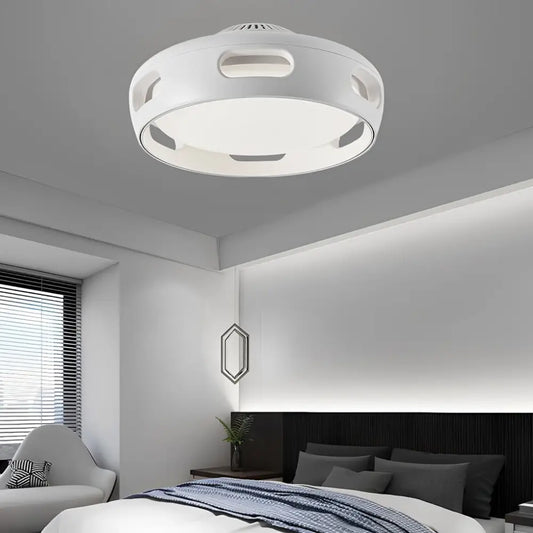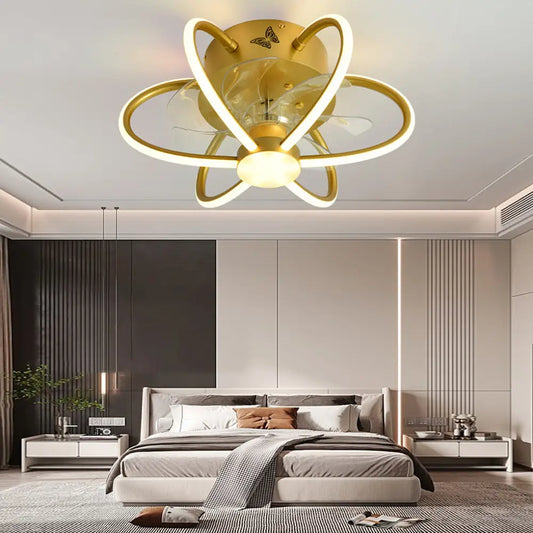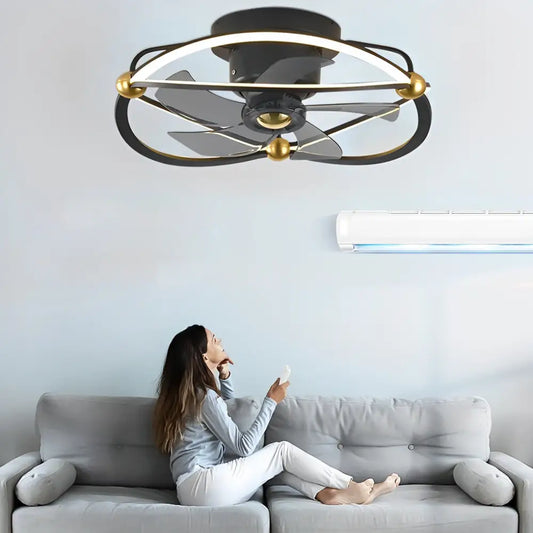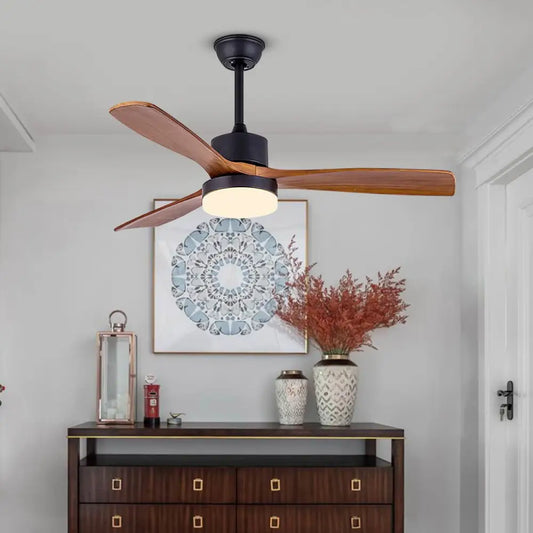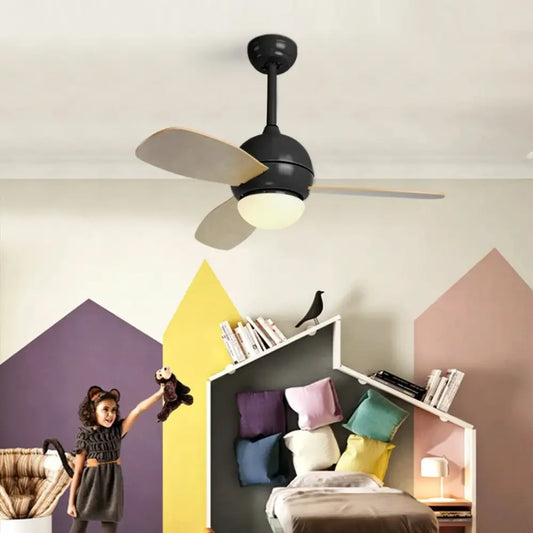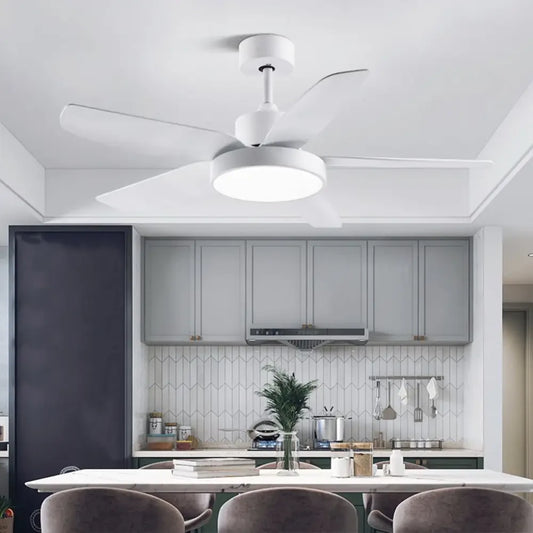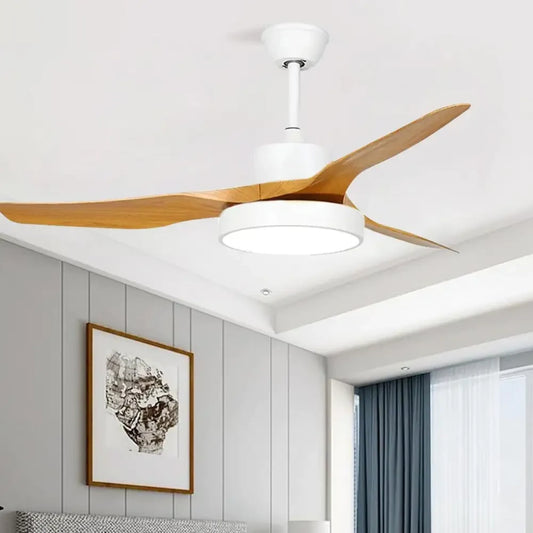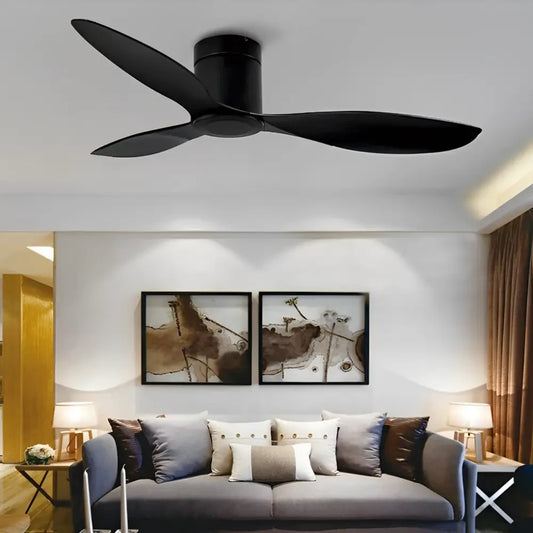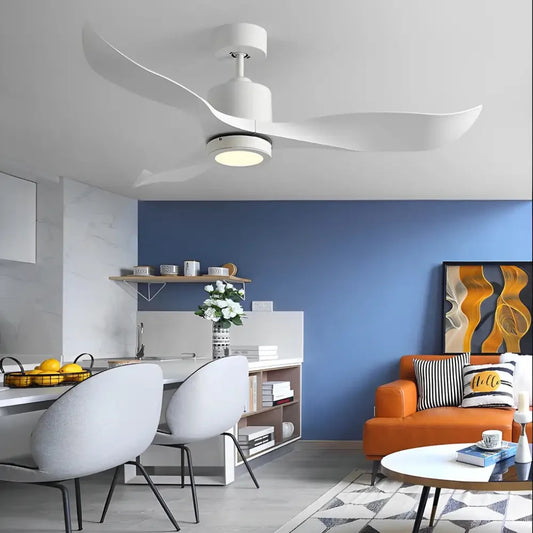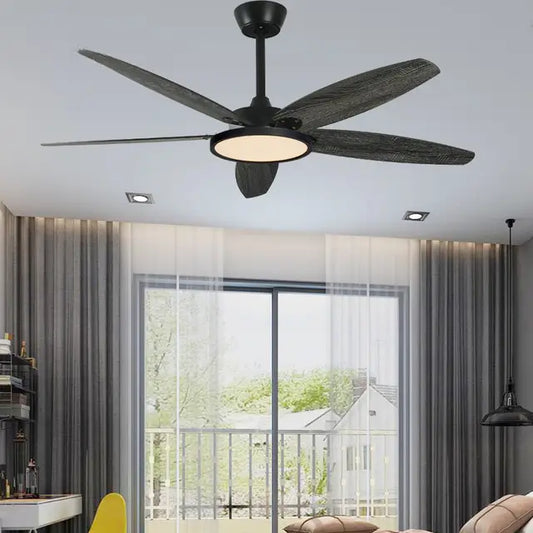Collection: Kitchen Ceiling Fans
-
52-Inch Modern LED Ceiling Fan with Remote Control
4.77 / 5.0
(13) 13 total reviews
Regular price From $235.37 USDRegular priceUnit price / per$0.00 USDSale price From $235.37 USD -
Antique Retro LED Ceiling Fan Light with Remote
Regular price From $420.05 USDRegular priceUnit price / per$0.00 USDSale price From $420.05 USD -
Circular Bladeless Ceiling Fan with Light and Remote
Regular price $440.38 USDRegular priceUnit price / per$499.99 USDSale price $440.38 USDSale -
LED Nordic Flush Mount Ceiling Fan Light Chandelier
Regular price From $406.08 USDRegular priceUnit price / per$0.00 USDSale price From $406.08 USD -
20 Inch Circular LED Modern Flush Mount Ceiling Fan Lamp
Regular price $275.45 USDRegular priceUnit price / per$0.00 USDSale price $275.45 USD -
Round Smart Dimmable LED Bladeless Ceiling Fan Light
Regular price $480.95 USDRegular priceUnit price / per$0.00 USDSale price $480.95 USD -
Flower Intelligent Dimmable LED Ceiling Fan Light
Regular price From $325.85 USDRegular priceUnit price / per$0.00 USDSale price From $325.85 USD -
Intelligent Adjustable LED Ceiling Fan Light with Remote
Regular price From $350.65 USDRegular priceUnit price / per$0.00 USDSale price From $350.65 USD -
3-Bladed Farmhouse Retractable Chandelier Ceiling Fan
Regular price From $633.65 USDRegular priceUnit price / per$0.00 USDSale price From $633.65 USD -
Nordic Minimalist Solid Wood LED Ceiling Fan for Living
Regular price From $302.99 USDRegular priceUnit price / per$0.00 USDSale price From $302.99 USD -
LED Bladeless Ceiling Fan Light with Flush Mount
Regular price From $306.85 USDRegular priceUnit price / per$0.00 USDSale price From $306.85 USD -
Gold Chandelier Ceiling Fan with LED and Retractable Blades
Regular price From $625.38 USDRegular priceUnit price / per$0.00 USDSale price From $625.38 USD -
36" Nordic Minimalist LED Ceiling Fan Light with Remote
Regular price From $330.85 USDRegular priceUnit price / per$0.00 USDSale price From $330.85 USD -
46 Inch LED Ceiling Fan with Remote and Timer
Regular price $335.48 USDRegular priceUnit price / per$0.00 USDSale price $335.48 USD -
3-Blade Rustic LED Ceiling Fan with Remote
Regular price $329.99 USDRegular priceUnit price / per$0.00 USDSale price $329.99 USD -
3 Blades LED Dimmable Ceiling Fan with Remote
Regular price From $293.99 USDRegular priceUnit price / per$0.00 USDSale price From $293.99 USD -
3 Blades LED Nordic Ceiling Fan with Remote and Light
Regular price From $477.99 USDRegular priceUnit price / per$0.00 USDSale price From $477.99 USD -
2 Blades Wood LED Ceiling Fan with Remote and Light
Regular price $392.99 USDRegular priceUnit price / per$0.00 USDSale price $392.99 USD -
36" Ceiling Fan with Plywood Blades, Light and Remote Control
Regular price From $433.18 USDRegular priceUnit price / per$577.58 USDSale price From $433.18 USDSale
Collapsible content
Kitchen Ceiling Fans Collection
If you are looking for a way to improve the comfort and style of your kitchen, you might want to consider adding a ceiling fan. A ceiling fan can help you create a pleasant and inviting atmosphere in your cooking space. It can also help you save energy and money by reducing the need for air conditioning or heating. A ceiling fan can also provide additional lighting and ventilation for your kitchen.
At our online store, we have a wide range of kitchen ceiling fans to suit any taste and budget. You can choose from different styles, sizes, and finishes to match your kitchen decor. Whether you prefer a modern, rustic, or classic look, we have the perfect fan for you. You can also find fans with various features, such as lights, remote controls, reversible blades, and more. All our fans are easy to install and operate, and they come with a lifetime warranty.
Browse our selection of kitchen ceiling fans and find the one that meets your needs and preferences. Order today and get free shipping on orders over $100.
FAQs of Kitchen Ceiling Fan
1. Is it a good idea to put a ceiling fan in a kitchen?
Yes, it is a good idea to put a ceiling fan in a kitchen, as it can provide many benefits, such as:
• It can improve the air quality and ventilation of the kitchen, by removing smoke, steam, odors, and grease from the cooking area.
• It can reduce the temperature and humidity of the kitchen, by creating a cool and dry airflow, making the kitchen more comfortable and hygienic.
• It can save energy and money, by reducing the need for air conditioning or heating, as well as the use of electric lights, as most ceiling fans have a LED light source.
• It can enhance the kitchen style and ambiance, by adding a touch of personality and elegance to the kitchen, as well as providing sufficient and soft lighting for the kitchen.
2. Which type of fan is best for the kitchen?
The type of fan that is best for the kitchen depends on the size, shape, and style of the kitchen, as well as the personal preference of the user. However, some general factors to consider are:
• The size and height of the ceiling fan, which should match the size and height of the kitchen, as well as the clearance from the floor and the cabinets. A general rule of thumb is to have at least 7 feet of clearance from the floor and 18 inches of clearance from the cabinets.
• The number and shape of the blades, which should provide enough airflow and coverage for the kitchen, as well as being easy to clean and maintain. A general rule of thumb is to have at least three blades and a curved or angled shape for better airflow and performance.
• The style and color of the ceiling fan, which should match the kitchen decor and style, as well as the personal taste and mood of the user. A general rule of thumb is to choose a ceiling fan that complements the kitchen theme and color scheme, as well as the lighting and furniture of the kitchen.
Some examples of types of fans that are suitable for the kitchen are:
• Bladeless ceiling fans, which are safe, quiet, and efficient, as they have no exposed blades that can cause injury or noise. They also have a sleek and elegant design that can match any kitchen style and decor.
• Flush mount ceiling fans, which are ideal for low ceilings and small spaces, as they can be installed close to the ceiling and save space and avoid the risk of injury or noise. They also provide both lighting and cooling functions, as they have an LED light source or a lampshade that can provide sufficient and soft lighting for the kitchen.
• Retractable ceiling fans, which are versatile and convenient, as they have retractable blades that can be tucked away when not needed, saving space and being neat and tidy. They also have a variety of styles, colors, and features to suit the user's taste and needs, such as chandeliers, pendants, or crystal designs.
• Chandelier ceiling fans, which are glamorous and luxurious, as they have a chandelier design that combines the function of lighting and cooling. They also add a touch of elegance and glamour to the kitchen, as they have a variety of shapes, sizes, and materials to choose from, such as crystal, metal, or wood.
3. What size ceiling fan is good for a kitchen?
The size of the ceiling fan that is good for a kitchen depends on the size of the kitchen, as well as the airflow and coverage that the user wants. A general rule of thumb is to measure the length and width of the kitchen in feet, and then add them together to get the diameter of the ceiling fan in inches. For example, if the kitchen is 10 feet by 12 feet, then the diameter of the ceiling fan should be around 22 inches. However, this is only a rough estimate, and the user should also consider other factors, such as the height of the ceiling, the clearance from the floor and the cabinets, the number and shape of the blades, and the personal preference of the user.
4. Why is there a ceiling fan in my kitchen?
There is a ceiling fan in your kitchen because it can provide you with many benefits, such as:
• It can improve the air quality and ventilation of your kitchen, by removing smoke, steam, odors, and grease from the cooking area.
• It can reduce the temperature and humidity of your kitchen, by creating a cool and dry airflow, making your kitchen more comfortable and hygienic.
• It can save energy and money, by reducing the need for air conditioning or heating, as well as the use of electric lights, as most ceiling fans have a LED light source.
• It can enhance your kitchen style and ambiance, by adding a touch of personality and elegance to your kitchen, as well as providing sufficient and soft lighting for your kitchen.
5. Does a kitchen fan use a lot of electricity?
No, a kitchen fan does not use a lot of electricity, as it is more energy-efficient than other cooling or lighting devices, such as air conditioners or electric lights. A kitchen fan uses less power and generates less heat than other devices, as it uses a turbine or a motor to create a powerful and smooth airflow, rather than relying on blades or bulbs to push or emit the air or light. A kitchen fan also has more options to adjust the speed, direction, and temperature of the airflow, according to the user's preference, saving more energy and money.
6. Why don't they put ceiling fans in kitchens?
Some possible reasons why they don't put ceiling fans in kitchens are:
• They are concerned about the safety and hygiene of the ceiling fans, as they may have exposed blades that can cause injury or damage, or accumulate dust and dirt that can contaminate the food or the air.
• They prefer other types of cooling or lighting devices, such as air conditioners or electric lights, as they may think they are more effective, convenient, or stylish than ceiling fans.
• They have low ceilings or small spaces in their kitchens, which may not be suitable for ceiling fans, as they may not have enough clearance or coverage for the ceiling fans.
• They have different tastes or preferences for their kitchen decor and style, which may not match with the ceiling fans, as they may find them too noisy, bulky, or outdated.
7. When should I use my kitchen fan?
You should use your kitchen fan whenever you want to improve the air quality and comfort of your kitchen, as well as enhance your kitchen style and ambiance. Some specific situations when you should use your kitchen fan are:
• When you are cooking or baking, the kitchen fan can remove the smoke, steam, odors, and grease from the cooking area, making your kitchen more ventilated and hygienic.
• When you are eating or entertaining, the kitchen fan can reduce the temperature and humidity of your kitchen, making your kitchen more comfortable and cozy.
• When you are cleaning or decorating, the kitchen fan can provide sufficient and soft lighting for your kitchen, making your kitchen more bright and elegant.
8. What is the kitchen fan called?
The kitchen fan is called a ceiling fan, which is a type of fan that is mounted on the ceiling of a room and uses rotating blades or a turbine to create an airflow that circulates around the room. A ceiling fan can also have a light source or a lampshade that can provide lighting for the room. A ceiling fan can have different types, styles, colors, and features, depending on the user's taste and needs.
9. Do kitchen fans remove humidity?
Yes, kitchen fans remove humidity, as they create a cool and dry airflow that reduces the moisture level of the air. Humidity is the amount of water vapor in the air, which can affect the temperature, comfort, and hygiene of the room. High humidity can make the room feel hotter, stuffier, and more uncomfortable, as well as promote the growth of mold, bacteria, and dust mites. Kitchen fans can remove humidity by creating an airflow that evaporates the water vapor from the air, making the room feel cooler, fresher, and more comfortable, as well as preventing the growth of mold, bacteria, and dust mites.
10. How do I keep my kitchen fan clean?
You can keep your kitchen fan clean by following these steps:
• Turn off the power and wait for the fan to stop spinning.
• Use a ladder or a stool to reach the fan, and wear gloves and goggles to protect your hands eyes, and skin from dust and dirt.
• Use a soft cloth or a microfiber duster to gently wipe the surface of the fan, the lampshade, and the blades, removing any dust and dirt. You can also use a vacuum cleaner with a brush attachment to suck up any loose dust and dirt.
• Use a mild soap or detergent and warm water to dampen another cloth or sponge, and gently scrub any stains or grease from the fan, the lampshade, and the blades. You can also use a degreaser or a vinegar solution to remove any stubborn grease or grime.
• Use a dry cloth or paper towel to wipe off any excess moisture from the fan, the lampshade, and the blades, and let them air dry completely before turning on the power.
• Repeat these steps as needed, depending on how often you use your kitchen fan and how dirty it gets.
11. How long can you leave a kitchen fan on?
You can leave a kitchen fan on as long as you need to, as long as it is working properly and safely. However, some factors to consider are:
• The energy consumption and cost of the kitchen fan, which may vary depending on the type, size, and speed of the fan, as well as the electricity rate in your area. You may want to turn off the fan when you are not using it or when you are away from home, to save energy and money.
• The noise level and comfort of the kitchen fan, which may vary depending on the quality, design, and location of the fan, as well as your personal preference and tolerance. You may want to turn off the fan when you are sleeping or relaxing, to avoid any disturbance or annoyance.
• The air quality and ventilation of the kitchen, may vary depending on the cooking activity, the temperature, the humidity, and the size of the kitchen. You may want to turn on the fan when you are cooking or baking, to remove any smoke, steam, odors, and grease from the kitchen, and to reduce the temperature and humidity of the kitchen.
12. How long should you keep a kitchen fan on?
You should keep a kitchen fan on for at least 15 minutes after you finish cooking or baking, to ensure that the air quality and ventilation of the kitchen are improved and maintained. You can also keep the kitchen fan on for longer, depending on your preference and needs, as long as it is working properly and safely.
13. How long does a kitchen fan last?
The lifespan of a kitchen fan depends on the quality, usage, and maintenance of the fan, as well as the environmental factors and conditions of the kitchen. A general rule of thumb is that a kitchen fan can last for about 10 years if it is well-made, well-used, and well-maintained. However, this is only a rough estimate, and the actual lifespan of a kitchen fan may vary depending on the specific model, brand, and type of the fan, as well as the frequency, duration, and intensity of the use, and the cleaning, care, and repair of the fan.
14. What is the difference between a kitchen fan and a bathroom fan?
A kitchen fan and a bathroom fan are both types of fans that are used to improve the air quality and ventilation of a room, by removing moisture, odors, and pollutants from the air. However, they have some differences, such as:
• The purpose and function of the fan, which are different for the kitchen and the bathroom. A kitchen fan is mainly used to remove smoke, steam, odors, and grease from the cooking area, and to reduce the temperature and humidity of the kitchen. A bathroom fan is mainly used to remove moisture, odors, and mold from the shower or bathtub area, and to prevent the growth of mold, bacteria, and dust mites.
• The location and installation of the fan, are different for the kitchen and the bathroom. A kitchen fan is usually mounted on the ceiling of the kitchen and is connected to a duct that vents the air outside the house. A bathroom fan is usually mounted on the wall or the ceiling of the bathroom and is connected to a duct that vents the air either outside the house or to another room.
• The size and power of the fan, which are different for the kitchen and the bathroom. A kitchen fan is usually larger and more powerful than a bathroom fan, as it has to deal with more smoke, steam, odors, and grease, and cover a larger area. A bathroom fan is usually smaller and less powerful than a kitchen fan, as it has to deal with less moisture, odors, and mold, and covers a smaller area.


